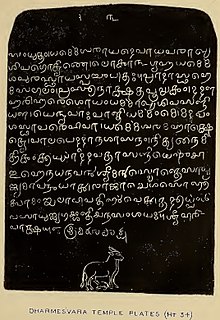Grantha script
| Grantha |
|
|---|---|

Sanskrit inscriptions written in Grantha script – Dharmeshwara temple copper plates, near Bangalore, Karnataka- Vijayanagara empire period.
|
|
| Type | |
| Languages | Sanskrit, Tamil |
|
Time period
|
6th Century CE -present |
|
Parent systems
|
Brahmi
|
|
Child systems
|
Cham alphabet Tigalari alphabet Malayalam script Sinhala alphabet Dhives akuru |
|
Sister systems
|
Vatteluttu alphabet, Kolezhuthu, Tamil script |
| Direction | Left-to-right |
| ISO 15924 | Gran, 343 |
|
Unicode alias
|
Grantha |
| U+11300–U+1137F | |
The Grantha script (Tamil: Kiranta eḻuttu) was widely used between the sixth century and the 20th centuries by Tamil and Malayalam speakers in South India, particularly in Tamil Nadu and Kerala, to write Sanskrit and the classical language Manipravalam, and is still in restricted use in traditional Vedic schools (Sanskrit veda pāṭhaśālā). It is a Brahmic script, having evolved from the Brahmi script in Tamil Nadu. The Malayalam script is a direct descendant of Grantha as are the Tigalari and Sinhala alphabets.
The rising popularity of Devanagari for Sanskrit and the political pressure created by the Tanittamil Iyakkam for its complete replacement by the modern Tamil script led to its gradual disuse and abandonment in Tamil Nadu in the early 20th century, except for specialised Hindu religious literature. Grantha script still lives in Tamil Nadu, albeit in reduced state.
In Sanskrit, grantha is literally 'a knot'. It is a word that was used for books, and the script used to write them. This stems from the practice of binding inscribed palm leaves using a length of thread held by knots. Although Sanskrit is now mostly written with Devanagari, Grantha was widely used to write Sanskrit in the Tamil-speaking parts of South Asia until the 19th century. Scholars believe that the Grantha script was used when the Vedas were first put into writing around the 5th century CE. In the early 20th century, it began to be replaced by Devanagari in religious and scholarly texts and the Tamil script (with the use of diacritics) in popular texts.
...
Wikipedia
